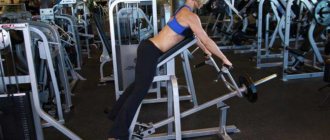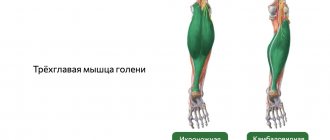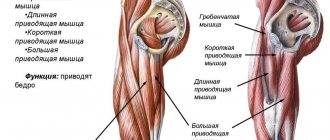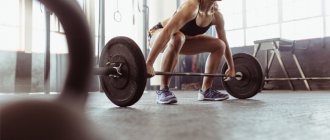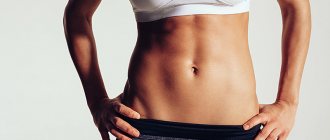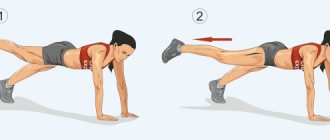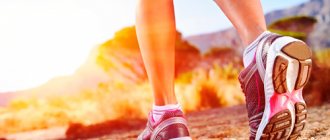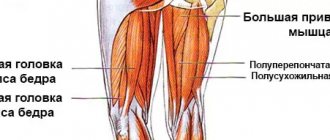In the human body, the muscles of the lower leg perform the most important tasks. Firstly, they are involved in any physical activity (walking, running, jumping). Secondly, they ensure the functioning of the circulatory system due to the muscular-venous pump (calves are often called the “second heart”). However, this area, especially the posterior calf muscle group, has become especially popular thanks to bodybuilding and fitness. Developed calves are the calling card of many athletes, which cannot be hidden even under clothing. Understanding how the lower leg muscle groups work, as well as the proper ways to train this area, will help you make steady progress in increasing strength, endurance, and muscle size.
Why you need to train your leg muscles
In home workouts, it is best to combine aerobic and strength training on the legs, this will allow you to get good results. By doing exercises regularly you can:
- burn a large number of calories;
- develop the overall endurance of the body and increase its strength and power characteristics;
- strengthen the muscles of the hips, pelvis, spine;
- strong, trained legs will reduce the risk of sprains and injuries;
- leg training has a positive effect on the functioning of the heart and blood vessels of the whole body.
At the beginning of the workout, a warm-up is performed; upon completion, stretching of the worked muscle groups is mandatory.
In a set of exercises for the leg muscles, it is enough to include 7-8 exercises, which need to be performed in 3-4 approaches, doing 16-20 repetitions. These numbers may vary depending on the type of exercise. For example, squats can be performed without weight 20-30 times, and leg swings 30-50 times in one approach.
It is worth remembering that classes should be regular, without absences, especially at the initial stage.
Before you start doing exercises at home, you need to think about what aids you may need for this:
- dumbbells,
- bodybar,
- ankle weights,
- Cardio machine.
But you can do without any special sports equipment at all and just buy a mat.
What are the main muscle groups in the legs?
There are quite large muscles in the legs. Their contraction or relaxation sets the whole body in motion. Small muscles help joints function and maintain posture. There are 4 large muscle groups located in the lower body. Each of them has a specific function and purpose:
- muscles of the front of the thighs;
- muscles of the back of the thighs;
- gluteal muscles;
- muscles of the inner thigh;
- muscles of the lateral (outer) thigh.
Additional recommendations
Even if you regularly perform physical exercises for varicose veins, do not expect an immediate effect. To eliminate the symptoms of the disease, you must also follow the following recommendations:
- Wear compression stockings. It significantly reduces pressure on the walls of blood vessels, relieves swelling and the feeling of fullness. However, you should use medical knitwear only according to a doctor’s indications - amateur efforts in this matter can lead to aggravation of the situation.
- Avoid being near a hot battery or open fire. Elevated temperatures interfere with normal blood circulation.
- Avoid eating excessively salty foods. If you have varicose veins, you should completely avoid table salt - it retains water in the body and interferes with normal fluid circulation.
- Take baths in the morning, not before bed. If possible, it is better to limit yourself to a shower.
- Watch your weight. In obese people, the load on all body systems, primarily the cardiovascular system, is significantly increased.
- Sleep - exclusively lying down. If you decide to take a nap on a sofa or chair, place your legs horizontally. Prolonged stay of the lower extremities in a vertical position significantly increases the load on the vascular bed.
In the treatment of varicose veins, an integrated approach is extremely important. Even surgery, sclerotherapy and other modern techniques will not give lasting results if the doctor’s recommendations are not followed.
Exercises for the hamstring muscles
The back muscle group of the thigh is different in that in everyday life it is not often exposed to various loads and fat accumulates here faster. By pumping this muscle group, you can solve several problems at once: remove fat from the thighs and buttocks, reduce cellulite and generally increase the strength characteristics of the legs.
The main exercises for the hamstrings are squats and lunges.
Squats
The squatting technique is simple, but it must be followed precisely so as not to injure the knee joints and pump up exactly the muscle group that is needed.
Stand up straight, place your feet shoulder-width apart, raise your arms parallel to the floor or place them behind your head. Perform a squat, starting the movement by moving your pelvis as far back as possible, as if you want to reach and sit on a chair standing behind you. Keep your back straight, focusing on your heels. Make sure that your knees do not move forward beyond your toes; ideally, the knee should not move forward at all.
Bridge on the mat
Take the starting position lying on your back. Place your hands along your body, palms down. Bend your legs at the knees and place the mat upright. With support on your heels and shoulders, lift your pelvis off the floor and smoothly, without jerking, lift it up as high as possible, bringing your body into a straight line. At the top point, squeeze your buttocks as much as possible, also smoothly lower your pelvis down, but do not put it on the floor, lift it up from the floor again.
Perform 20-30 lifts and 3 sets. When the exercise is easy, you can make it more difficult by adding weight - a body bar or disk in the pelvic area. This exercise also works great on the gluteal muscles.
Lunges
Technique:
- Stand up straight, legs hip-width apart, feet parallel, hands on your waist or to the sides.
- Step one foot forward. Lower yourself down, bending your outstretched leg, until the angle at your knee becomes 90 degrees.
- The back leg should rest on the toe.
- Push off with your front foot and return to the starting position.
Repeat the exercise 20 times on each leg. If possible, you should do 2-3 approaches.
Inclusion in the program
This is a single-joint movement, even though we are sitting with our knees bent. For an uninjured person, it is included in the program after multi-joint leg work, such as squats or leg presses. You should be careful with the load, and do not use such a weight that the athlete cannot lift more than 10-12 times.
The exercise can be performed several times a week, and combined with a squat on each day if the goal is to strengthen the hip adductors to correct technical weaknesses in the squat.
Exercises for the muscles of the inner thigh
Plie squat
In addition to the inner thigh, the gluteal, quadriceps and calf muscles are also strengthened here.
Starting position: place your feet about 2-3 times wider than your shoulders, spread your toes to the sides at 45 degrees, and straight back. Move your pelvis forward.
As you inhale, slowly lower yourself down until your thighs are parallel to the floor. Hold for a second at the bottom and, as you exhale, slowly rise to the starting position.
Plie squats should be done 10 to 15 times in 2-3 approaches.
Leg extensions to the sides from a lying position
The load in this exercise is placed on the adductor muscles of the thigh, and the lower part of the abs is additionally involved. If necessary, you can complicate the exercise with weights on your legs. You need to start the exercise with 15-20 repetitions and 2-3 approaches, gradually increasing the load every week.
Technique:
- Starting position - lying on your back, arms along the body, straight legs raised perpendicularly upward.
- Inhaling deeply, slowly spread your legs to the sides, lowering them to the most comfortable point for you, hold for a second. As you exhale, slowly raise your legs to the starting point.
- At the end of the entire complex, stay in the spread-legs position for 20-30 seconds and do some springing.
The main thing in breeding is accuracy and slowness; sudden movements can lead to sprained ligaments.
Side Lunges
Warm up the pelvic ligaments well before lunges. Otherwise, the ligaments may be stretched or even torn. The exercise perfectly loads the inner thigh, as well as the gluteal muscles; in addition, the ligaments are stretched. You can make it more difficult by holding a dumbbell in your hand.
Technique:
- Legs are 4 times wider than shoulder width, abs tense, back straight, arms clasped in front of you.
- As you inhale, squat on your right leg with emphasis on your heel, bring your knee to 90 degrees, while your left leg is completely straight, your foot pressed firmly to the floor. Hold for 1-2 seconds.
- Return to the starting position and lunge on the other leg.
Lunges should be performed 12-15 times on each leg, doing 2-3 approaches.
The plank pumps up all major muscle groups, including the buttocks and thighs.
Ball pinching
Exercise for static muscle work - muscle contraction and retention in this state. Additionally, the buttocks are tensed here. Despite the slight complexity, the exercise is very important, aimed at concentration and endurance.
Technique:
- Take the starting position lying on your back, knees bent, feet pressed firmly to the floor. Place a small ball between your legs near the knees.
- As you inhale, squeeze the ball forcefully and hold the position for 2-3 seconds.
- As you exhale, relax your legs without dropping the ball.
Repeat the exercise 10-15 times, 3-4 approaches.
How to treat pain in the calf of the left or right leg
If you feel pain in your calf muscles, contact the Yusupov Hospital. Doctors will prescribe anti-edematous and anti-inflammatory treatment. After a comprehensive examination using x-rays, computed tomography and magnetic resonance imaging, blood and urine tests, a collegial decision will be made on treatment for the syndrome that causes pain in the calf muscles.
Severe cases of diseases that cause pain in the lower leg muscles are discussed by professors and doctors of the highest category at the Yusupov Hospital at a meeting of the expert council. Leading neurologists, rheumatologists, orthopedists, and rehabilitation specialists establish an accurate diagnosis and jointly develop tactics for further patient management. A comprehensive treatment is carried out aimed at eliminating the cause of pain, the mechanisms of development of the pathological process and relieving the pain syndrome. Therapy is carried out with effective drugs that have a minimal range of side effects.
After treatment, patients are offered a comprehensive rehabilitation program. It allows you to get all the necessary procedures at a stable price and save money. If you experience pain in the calf muscle, call the Yusupov Hospital, where the call center is open every day 24 hours a day, without days off or lunch breaks. Doctors provide emergency medical care around the clock.
Exercises for the muscles of the lateral (outer) thigh
One of the most effective leg exercises is lateral leg raises in a lying position. This exercise is weighted using your own weight, but you can put sandbags on your calves.
Lateral leg raises in a prone position
Technique:
- starting position - lie on your side, with your hand below at chest level in front of you, the other located behind your head;
- as you exhale, lift your upper leg until it is parallel to the floor;
- as you inhale, lower it down, but don’t put it down, but immediately lift it up again.
Repeat 30-35 times and turn over to the other side.
Do the same work with the other leg.
Leg abduction in a kneeling position
Together with the outer side of the thigh, this exercise also works the inner part. The complexity of the exercise is small, so with sufficient preparation, you can additionally hold a dumbbell in the bend of your knee.
Starting position – standing on all fours, focusing on straight arms, knees and toes. Legs are bent at the knees. If using a dumbbell, place it at the crease of your thigh and shin.
As you inhale, move your bent leg to the side until it is parallel to the floor, hold it for 1-2 seconds, and return your leg to the starting position. Perform all movements smoothly and slowly, without jerking.
Do a working number of repetitions, approximately 20-30 lifts, then remove the weight if you were using it and perform another 10-15 similar movements. Then do the exercise on the other leg.
Exercises for the muscles of the anterior thigh (quadriceps)
Stepping onto a support
If possible, make the exercise heavier with dumbbells.
The exercise works all the leg muscles and even engages the abs, but the quadriceps are especially heavily loaded. You will need a hard surface to walk on - a chair, stool, bench, box.
Technique:
- Starting position – legs together, back straight.
- As you inhale, step one foot onto the support, the other leg hangs for a second.
- As you exhale, return to the floor and perform the same exercise with the other leg.
Walking is performed in 15-20 steps on each leg, 2-3 approaches are done with a break of 1 minute. For additional load, you can linger at the top point for 30-40 seconds, periodically springing your supporting leg.
Bulgarian lunges
This isolation exercise has a visible tightening effect on the quadriceps area without overstraining or overstraining it. The complexity of the exercise is high, since in addition to performing lunges, it requires concentrating on maintaining balance.
Lunges will also work the muscles in the back of your thighs and buttocks.
Technique:
- Take the starting position - your left leg rests on the support, your right leg is relaxed and put forward.
- As you inhale, perform a lunge with emphasis on your right leg until your knee reaches 90 degrees.
- The support in the foot is on the heel. As you exhale, return to the starting position.
To get noticeable results, you need to do 15-18 lunges on each leg, doing 2-3 such approaches with a minute break between them.
Signs of circulation problems
Symptoms of chronic circulatory failure in the brain may not appear until a situation requiring abundant blood supply: stress, unusual physical activity, or being in an unventilated room. They appear suddenly: headache, numbness of part of the face, loss of coordination of movements, tinnitus.
Chronically, the following symptoms may appear: frequent dizziness, decreased memory and performance, poor concentration, drowsiness or insomnia.
Signs of impaired blood flow in the extremities include intermittent claudication (pain when walking and its absence at rest), cold hands and feet in any weather, the formation of spider veins, heaviness, fatigue, swelling, cramps in the leg muscles.
Exercises for the muscles of the gluteal region
Deadlift with dumbbells
Deadlifts with dumbbells perfectly work out the gluteal muscle group, and also additionally load the back of the thigh. Dumbbells can be taken at once with a large weight, at least 4 kg.
Stand straight, feet hip-width apart, toes turned slightly inward - this will reduce the load on your lower back. Take dumbbells in your hands and place them at the front of your thighs. Lean forward with straight knees. If it is very difficult to keep your knees stretched, you can bend them a little.
Lower your hands with dumbbells from the hip joint to the middle of the shin and lift them back. It is very important that the back should be straight with a natural curve in the lower back.
Perform this exercise 15 times, for a total of 2 approaches.
The benefits of physical therapy
Regularly performing simple physical exercises will help:
- improve venous and lymphatic drainage;
- normalize arterial blood flow;
- restore the patency of the vascular bed in the damaged area;
- significantly reduce dystrophic changes in the tissues of the lower extremities;
- relieve heaviness in the legs, relieve swelling.
Also, exercise will help normalize skin tone, restore its healthy color, and stimulate regenerative processes in the deep layers of the epidermis.

